CONREGO: Online Event Bookings with Unlimited Registrations [Review]
##abovethefold##
CONREGO: What Is It?
CONREGO is an online event registration platform, which offers other notable event management features, including a responsive event website, mailings by email and SMS, abstract submissions and review and accommodation room block management.
There are three package options available, depending on the features you need. The pricing is annual and includes unlimited attendee registrations and user accounts for staff. This model means that the more events you run and greater the number of tickets sold, the lower the cost per head. When compared to other platforms which are priced per registration and/or per user, this may be a very appealing proposition for many event planners. Payment gateway integrations let you automate payments and invoicing. Of course, there will be the charges per transaction as determined by the payment gateway, but no additional cut is taken by CONREGO. Currently, there are 10 integrations to choose from, including PayPal, Stripe, and Braintree.
The registration form can be customized to create different registration forms for different participation types (standard attendee, press, VIP, speaker, etc.). You can freely add any number of form fields and divide them into sections. It also includes a comprehensive agenda, where particular items can be limited in terms of number of registrations, visibility for specific ticket types, and date. In terms of accommodation, you can add hotels, room types, and set separate quantity limits for each day of the conference and rules, such as a minimum two-night stay.
The responsive event website can feature any number of subpages and content (in any number of language versions) that can be built using an editor or elements that function as building blocks. There is a good number of predefined types of elements; a photo gallery, Google map, event programme, contact form, banner, countdown timer, and more can be added easily. You can also build your own using HTML. In the creator, you can adjust basic visuals, like the main banner, event logo, fonts, buttons, etc. You can easily add tracking codes, such as Google Analytics and Facebook Pixels, within the header and footer of the website.
The Mailings module allows for personalized mass mailing (including SMS messages), and can attach personalized PDF files, created with the PDF creator module. This can be used for personal RSVP-based invitations or to deliver tickets with QR codes to your attendees. QR codes can then be scanned at the reception desk, or manual check-in can be used, by name or ID number to verify if that person has registered and note their attendance to create reports afterward. QR codes can also be scanned at any room in the venue to verify if the attendee has registered for a particular event on the agenda.
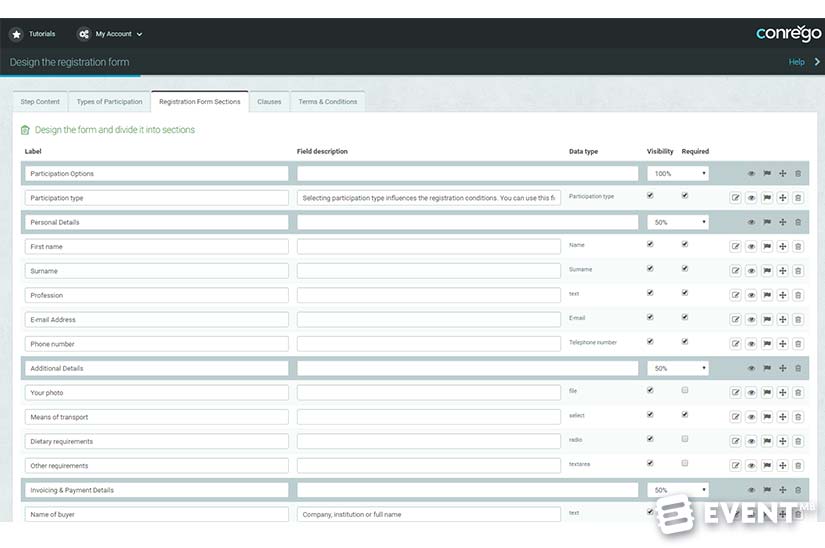

The Main Categories of Features Are:
Event Website. Create a responsive event website, add sub-pages and premade elements, such as photo gallery, Google maps, countdown timer, banner and contact form.
Event Online Registrations. Create a highly customizable registration form and place it on any subpage of the event website, or on any external website. Manage accommodation bookings for your hotel room blocks.
Event Management. Manage your event registrations, hotel room blocks and speaker abstracts and run useful reports. Manage check-in and access control on site.


Review
When you log into your CONREGO account you are straight into your dashboard, which shows you the most important information and financials right away on a single screen. You can select the data you want and download premade reports, easily see and access recent activity and see a running tally of session and room bookings and the number remaining.
You can add as many users as you wish and decide on their access levels. There is no additional cost per team member. This also allows you to track who made changes within the system.
We understand that some users have found the software complex but if you are an event planner that has used an online event registration before it shouldn’t take you too long to get to grips with it. Some level of complexity is necessary to be able to customize the system to your event specifics. There are two main tabs: the Configuration Menu, which is important to work through for the setup process. You shouldn’t need to visit this after the event is live. The User Menu features everyday use modules for attendee data processing, communication, and other processes. There are tutorials and support via LiveChat, email, and phone.
The registration process is divided into steps:
- Info
- Agenda items and prices
- Accommodation booking
- Summary (the attendee can still change booking details)
At this stage, the customer is directed to the integrated gateway to make their payment if paying by card.
- Confirmation
Registration
The customizable registration form can be placed on any subpage of the event website, or on any external website. You can add any number of participation (ticket) types, assign them limits, separate registration forms and prices. Different types of tickets/participation can display different registration forms, event programs, accommodation options and pricing. You can add and embed your terms and conditions and you can have more than one document, however, all clauses are visible for all participation types.
Discounts can be offered and these can be hidden (accessed only by a trackable URL) or public (activated by entering a code). There can be limits for each participation type and any discount codes issued. The system enables you to generate a unique, randomly generated individual participation code, which can be issued for closed events to ensure only one time sign up.
Comprehensive reports let you browse, filter, group, and change registrations in the system. You can also download them as .xls files.
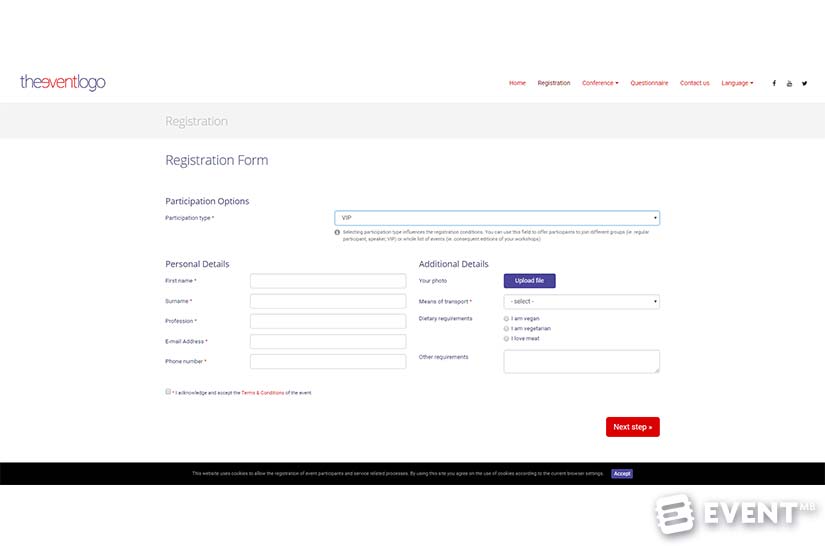

Event Agenda
You can create a comprehensive event agenda with descriptions, mandatory items (such as plenary sessions which everyone should attend), mutually exclusive items, and time-limited items. Different ticket types can see different agenda items, if you wish. You can add quantity limits to sessions and fringe events, to ensure that there is no overbooking in terms of room capacity.
Blocking rules are there to prevent people from booking items taking place at the same time, or from different thematic tracks. The event planner sets these rules though, so be careful to test and get it right before your registrations are open.
Payments
Prices can be assigned to different items, such as sessions and additional events with a fee attached. It can be set so that only certain types of participants have to pay, for example, VIPs, speakers and press might have free entry to all areas of the event, whereas standard attendees have to pay if they want a ticket to the conference dinner. Payments can be taken in different currencies, with the rate set manually (as in not subject to exchange rate fluctuations) and tax/VAT payable set for each item and currency. One downside is that if you are accepting different currencies and have different bank accounts there is only the option to list one account on the invoice.
Payments can be paid by bank transfer and payment confirmation can be entered into the system manually when this is verified or automatically verified when a card payment is taken by your chosen payment gateway.
Two types of invoice are created by the system if at least one item with a price attached has been selected. A pro forma invoice is generated if the booking is made but no payment is taken, for instance, if the attendee wishes to pay by bank transfer. On the system, you can specify the invoice payment terms (e.g. 7/14/31 days) and also the invoicing number format. Not all online registration systems allow the invoice numbering to be specified, sometimes resulting in randomly generated and ridiculously long reference numbers, so this was good to hear. Automatic payment reminders can be issued at intervals you specify. If payment is not received within a certain time period the booking can automatically be canceled and the place released if you wish.
A tax invoice is then generated when the transaction has been completed and payment is taken. If a BACs payment is taken the tax invoice needs sending on manually if the attendee requires it. The gross price is listed in the system and a breakdown of any tax is given on the invoice.
Accommodation
A big advantage of CONREGO is the ability to offer various accommodation options and manage your hotel room blocks through the system. When you have negotiated with different hotels and agreed on the number of rooms to be held, and the rate for each night, these details can be entered into the system. You can choose to hide hotel options for different guests, or after the booking cut off date and add minimum booking periods. You can include photos, maps and details for the different hotels and you can add as many options as you wish. Payment for the hotel is then taken with the event ticket, to ensure no risk for the event planner.
For events with multiple special rates and negotiated agreements with one or more hotels, this will save a lot of time for event planners. Reports can easily be viewed and generated to see what percentage of rooms are taken and give regular updates to the hotel. It encourages attendees to book their hotel at the same time as booking their ticket, maximizing the chance of them going through the official event channel and therefore increasing the commission earned and keeping attendees within your chosen hotel options.
On-site Check-In and Access Control
At the registration desks or access point, you can search by entering all/part of the first or last name of the attendee. Alternatively, the QR code can be scanned. If you need to control access to additional areas or special elements it will verify whether or not the attendee is eligible. A running total can be given for check-ins in any specific area. You can check attendees in and out of sessions if you wish, which is handy to monitor attendance, for instance, if timestamp evidence is needed for professional education credits.


Abstracts (Surveys)
Call for abstracts or papers can be done via the system. Reviewers and categories can be added and assigned to applications so that they can rate them. The event planner can be automatically notified when a submission is reviewed so they can accept or reject submissions, using automated messages.
PDF Creator and Mailings
The PDF creator allows templates to be created with bespoke backgrounds added. These can be used to create certificates, tickets or badges and can be mass created based on groups of attendees, or generated individually. Personalized documents can be sent out by email. SMS text messages can also be issued.
Code editor
A set of code editors allow advanced users to customize the website and registration form even further, e.g. by coding jQuery conditions or modifying CSS styles. These editors also let you inject any tracking code and easily integrate with external analytics tools.
If you or your team have knowledge of CSS or javascript you can further customize the event website and registration form, for instance, to enable group bookings to be accepted or to create conditional logic based on any field on the registration form.
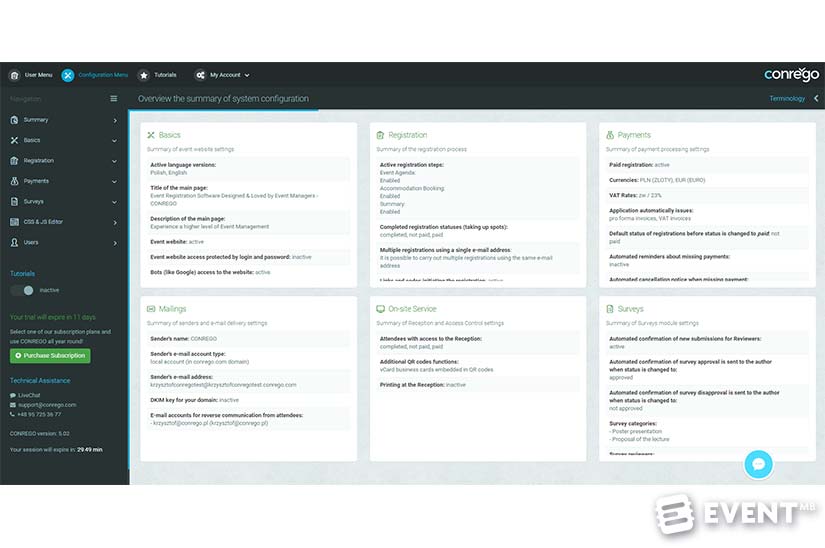

Features
Event Website
- create a responsive event website
- any number of subpages optionally divided into categories
- dedicated news or microblog tool
- a good number of premade website element templates, including gallery, Google map, event programme, contact form, banner, countdown timer, and more
- host your website on your own domain
- easily change basic styles of the website, like fonts, colors of backgrounds, text, buttons
- add social media buttons in the header
- change CSS styles used on the event website
- add any code to the website header or footer – use this option to add tracking codes for external analytics services
Event Online Registrations
- create a highly customizable registration form and place it on any subpage of the event website, or on any external website
- add any number of participation types, assign them limits, separate registration forms and prices
- create a comprehensive event agenda with descriptions, compulsory items, mutually exclusive items, and time-limited items
- build a list of available hotel rooms
- fully customize any step of the registration process – the content, the form fields, descriptions, colors, etc.
- build a flexible price list for different currencies and apply VAT rates to individual positions
- prices can be different for participation types and separate periods of time – you can employ an early bird, regular, last minute policy
- customize and automate proforma and VAT invoicing
- integrate with up to 10 payment gateways to automate payments
- attach static or personalized PDF files to booking confirmation emails
- set up automated messages with confirmation of transaction, payment reminder, and registration cancellation
- add any number of discount codes that can be time-limited, number of uses limited, and only cover selected items on the agenda
- browse, filter, sort, group, and change registrations
- carry out mass actions on selected registrations
- import registrations from .xls files
- export registrations to .xls files
- browse payments and invoices
- add comments to registrations
- download reports of available spots for agenda items and hotel rooms
- use jQuery to change how the registration form works
Event Management
- mass send personalized email or text messages
- send email containing an invitation link as an RSVP
- most important data on a single screen
- download premade reports with one click
- easily access registrations recently commented on
- view the number of spots left on agenda items and in hotel rooms
- handle the event reception desk and use QR codes or manual search to acknowledge attendance and verify entry rights
- print out personalized ID badges
- change registration data if necessary
- add new attendees at the reception desk
- carry out access control to check if an attendee has registered for a particular agenda item
- track the movement of your attendees between checkpoints
- use the entry and exit mode to determine how long an attendee has attended an event on the agenda
- gather abstract submissions from speaker candidates using the survey feature
- let your candidates assign their submission to categories so that the submission is rated by experts in the field
- have your reviewers comment and rate the submissions from their field of expertise
- accept or reject submissions
- send automated messages when receiving submissions and accepting or rejecting
- alternatively use the survey tool as another registration form, although its functions are different than the functions of the registration form, or to gather feedback
- create personalized PDF templates
- generate multi-page personalized PDF files
- attach PDF templates to emails to be personalized on the fly
- place any registration data and a QR code or barcode on your templates
- use PDF files as tickets
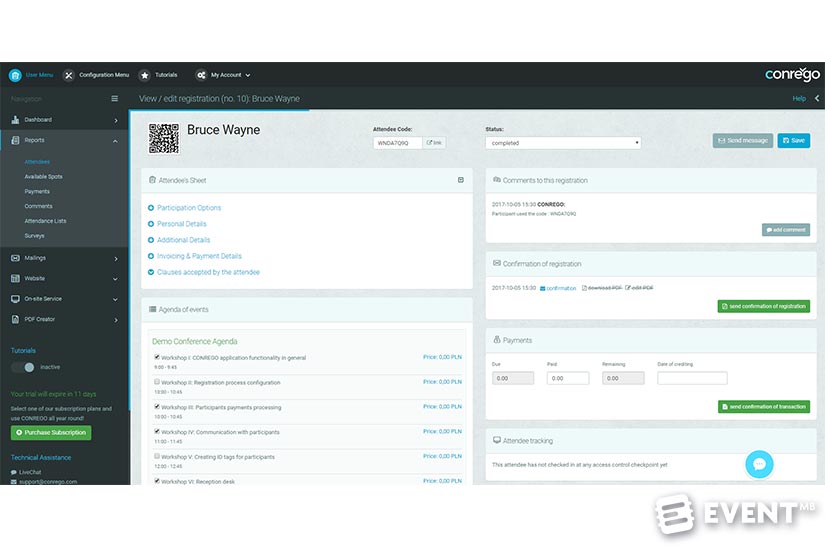
Who Is It For?
CONREGO is for anyone that organizes events, particularly conferences, meetings and training. The features will be particularly beneficial for those that want to accept a call for papers/abstracts and review process, manage accommodation blocks, and accept payments in multiple currencies.
Pros and Cons
Pros
- The annual pricing is for unlimited users and attendee registrations, meaning the more you use it the better value it is. Compared to other systems which are priced per booking this may be very appealing to event planners, particularly considering inclusive features such as marketing mailings, check-in/access control and submissions/review process.
- The accommodation and room block management is a great feature if you want to offer hotel bookings with your event tickets.
- It is possible to accept payments in multiple currencies, and specify different tax rates.
- Call for abstracts and papers can be accepted on the Pro plan.
Cons
- Feedback from some users is that the configuration and number of functions may be overwhelming.
- No conditional logic available for the registration form (unless your team can edit the javascript).
- There is no mobile app, although the administration panel is fully responsive.
- No group booking option.
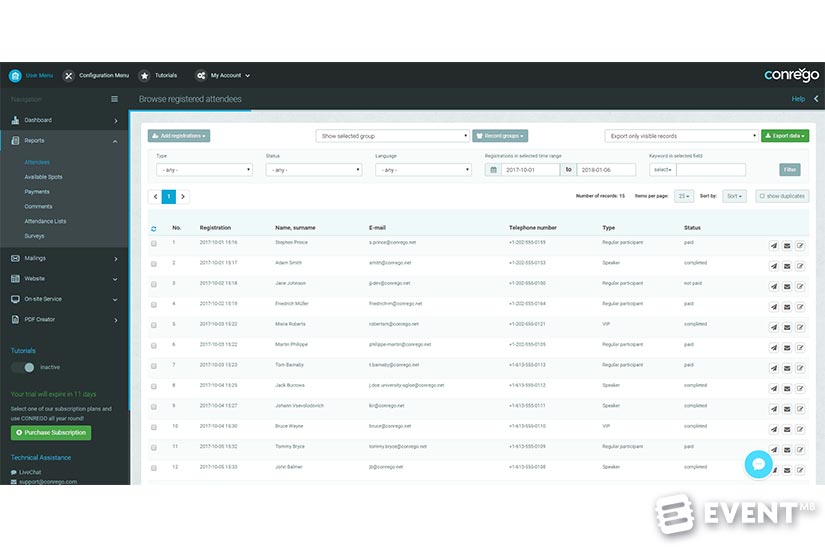
Pricing and Plans
A 14-day free trial is available.
There are three annual subscription plans. All plans are unlimited in terms of the number of users and the number of attendees. The direct registration cost per attendee goes down as the number of attendees increase.
Basic – $497 per year. Features the Dashboard, Registration, Payments and billing, Mailings, Reports, and Code editor.
Pro – $997 per year. Features everything the Basic version does plus the Event Website and Surveys/Abstracts.
All-in-One – $1,497. Includes all features in the Pro plan, plus includes on-site check-in, access control, ID badges and PDF file creation.
In Conclusion
CONREGO is an online event registration software with some juicy event management features. Not having a group booking option as standard might be a deal breaker for some but if you are interested in SMS communication, managing your room blocks, accepting abstract submissions and collecting payments in multiple currencies this solution should be explored, right now. The annual package plans, offering unlimited registrations could offer you excellent value for money.
With the 14-day free trial – why not give CONREGO a test drive to see if it is right for your events? You have nothing to lose!
Disclaimer: Reviews are paid for placements. While Event Manager Blog receives a fee to extensively look at the tool and review it in detail, the content of the review is independent and by no means influenced by the company. If you have any questions please use the contact us section.
![CONREGO: Online Event Bookings with Unlimited Registrations [Review]](https://meetings.skift.com/wp-content/uploads/2018/01/conrego-review.jpg)